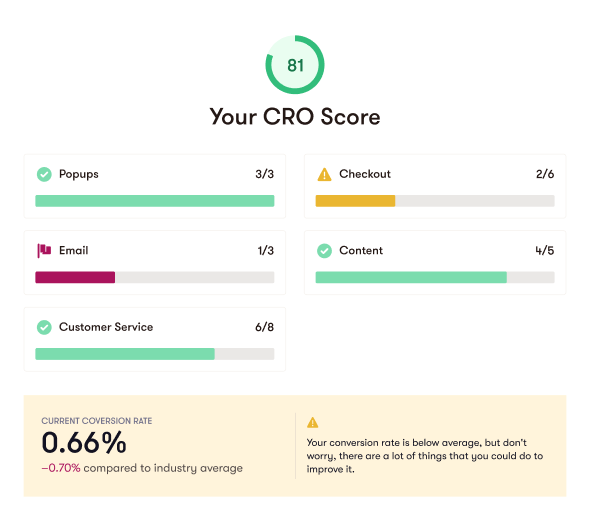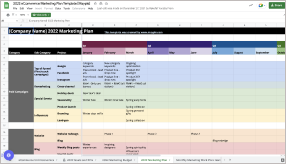The Future of eCommerce: 7 Predictions for Hyper-Growth
Learn about the Future of eCommerce - Personalization, Increased focus on the Customer Experience (CX), Curbside delivery, DTC brands, and Retention strategies.
DOWNLOAD TEMPLATEAt the height of the pandemic, global eCommerce sales hit an all-time high. Digital Commerce 360 found that retail eCommerce sales went up 44% YoY, as retail sales in the United States fell from 5.47 to $4.89 trillion dollars.
Travel bans and lockdowns forced consumers — not just Millennials or Gen Z, but even older generations — to shop online. Retail sales continued to plummet even as physical stores re-opened. Customers simply preferred the convenience, efficiency, and speed of shipping and fulfillment that comes with eCommerce automation.
Years of changes took place in just a few months, which left many eCommerce websites and traditional retail stores scrambling to innovate and get at the forefront of those changes.
This article highlights some new and emerging eCommerce trends to watch out for along with predictions for the future. We’ll also share how you can jump aboard them to boost the local and international growth of your online business.
Let’s dive in.
[Add Banner Here]
1. eCommerce adjusts to the "New Normal"
The COVID-19 pandemic brought about the greatest behavioral shift to people's shopping habits in recent times — the most visible of which is the growing traction for online shopping.
According to Shopify’s Future of eCommerce report, 79% of consumers have expressed a desire to buy online regularly in six months’ time. However, a significantly fewer number (57%) have indicated that they might shop in-store regularly in that time.
A direct consequence of eCommerce penetration is the predominance of a younger, more tech-savvy demographic with high purchasing power in the eCommerce landscape.
They leverage social media platforms, review sites, online forums, and peer recommendations to thoroughly research products before buying. They’re also likely to influence the buying habits of older members in their family and peer groups.
To meet their unique demands and to scale your eCommerce business, you will need to engage this demographic effectively using social commerce and influencer marketing.
Some eCommerce brands are already using Augmented Reality (or Virtual Reality) to enable customers to try out products before buying, and many are engaging their audiences on Facebook and Instagram through exciting virtual shopping experiences.

Both these social media platforms allow you to create a digital storefront where you can showcase your assortment of products to your audience. You can further engage them using live videos, Stories, Reels, and shoppable Instagram ads to direct them to your virtual store.
Benefit Cosmetics is a brand that does this really well. They use Facebook Live to host weekly sessions where they share useful makeup tips and tutorials with their audience. Here’s an example of a video where they take an educational approach to promote their products.
2. Personalization is going to be everywhere
eCommerce personalization helps you transcend the transactional nature of your customer relationships to offer them an exceptional consumer experience. In fact, research suggests that 80% of consumers are more likely to buy from a brand that offers a personalized experience.
However, personalizing the eCommerce experience goes beyond just using people's names in your communications with customers. eCommerce businesses are, in fact, starting to leverage hyper-contextual targeting based on Artificial Intelligence (AI) to improve the online shopping journey, especially for beauty eCommerce brands.
This involves using hyper-local data such as a customer’s location, demographics, shopping activities, and history to craft meaningful content and deliver a compelling shopping experience on every platform.
Personalization involves utilizing all the information you have about your customer's shopping journey to enhance their online purchasing experience and improve conversions. Here are some popular segmentation strategies that you can leverage in your digital marketing to grow your eCommerce business:
- Geographical data: This involves creating a tailored online experience for a customer based on their local geographical attributes such as the weather. For example, when it starts raining in Texas, you might want to pronounce the visibility of your rubber boots in your marketing messages.
- Referrer source: This involves tweaking your communication based on the source that brings you a lead. You can’t use the same tactics to engage a lead that comes from LinkedIn as one that comes from Facebook.
- Past purchase data: Data on the past purchases of your customers can offer crucial insights into consumer behavior and preferences as well as what stage of the consumer journey they’re in. This can help you serve them relevant product recommendations. For instance, on their shopping cart page, you could suggest products that they buy frequently or are likely to run out of soon.
Amazon is known to perfect the art of personalization. For example, customers who’ve recently bought beard grooming products like razors and trimmers could also be interested in beard wax, beard oil, conditioners, beard brushes, or fragrances. Amazon does a great job of displaying personalized recommendations in their “also bought” section.

3. Greater focus on the Customer Experience (CX)
As global eCommerce growth continues to soar, the digital experience as a whole is changing dramatically. Consumers today expect an intuitive and easy-to-use digital experience across every communication and sales channel. Brands must focus on delivering engaging omnichannel experiences throughout the customer journey.
Physical stores are undergoing a digital transformation as well. Shopify’s proprietary data has revealed that brick-and-mortar stores with an omnichannel strategy have successfully recovered 94% of in-store purchases that were lost in the first month of the pandemic through online sales. So there is a lot more pressure for eCommerce stores to make this a top priority.
The customer experience (CX) your consumer is comprised of three main stages:
Pre-purchase experience
How does the customer get to know of your brand? Where do they experience your brand communications and advertising? To stay relevant and competitive, you need to enhance your presence across all available channels such as retail, wholesale, social media, and online marketplaces.
The shopping experience
The ease of navigation of your eCommerce store together with the products, pricing, and payment options you offer will determine the actual shopping experience.
Solo Stove, for example, offers compelling shopping experiences through its navigation menus and detailed product pages. It also offers tons of valuable content to help users learn how to use their products and provides an easy online checkout with multiple payment options.

Responsive online stores are those that offer a consistent user experience across all digital devices. A study by Shopify Plus found that 53% of consumers abandon websites that take more than three seconds to load on mobile devices. With the rise of mobile commerce, it’s important for you to adopt a responsive design that improves your site speed, SEO, and overall mobile shopping experience.
You should also consider converting your eCommerce site to a progressive web app that offers an optimal user experience on mobile devices. Many eCommerce sites are even combining their apps with accelerated mobile pages to deliver unparalleled mobile shopping experiences.
Post-purchase experience
Is your team available to answer questions, provide support, and gather feedback across multiple communication channels? This is essential to delivering unique branded experiences and racking up eCommerce sales.
Regular updates on new offers, products, promotions, and birthday/anniversary discounts are great ways to keep your customers engaged post-purchase.
As eCommerce marketers look for new ways to delight online shoppers, headless commerce continues to grow in popularity. It’s one of the most interesting trends shaping the future of global eCommerce.
A headless architecture decouples the back-end functionality of your eCommerce platform from the front-end eCommerce experience. This gives you the liberty to opt for different types of tools or services (like an improved UI or content management system) to create more compelling shopping experiences.
4. Diverse and improved delivery experience
The way products are delivered is changing. Giants like Amazon are launching an in-garage delivery experience for grocery delivery orders. Curbside pickup or the “Buy-online-pickup-in-store” (BOPIS) have become quite popular.
Customers can simply place their orders online and pick them up outside the store, without having to even leave their car.

A study by National Retail Federation found that 43% of customers have already used curbside pickups and 81% are keen on trying them out. Shopify found that customers who buy online and pick up in-store spend 23% more than the ones who choose regular shipping. The former group also has a 13% greater likelihood of completing their online purchases.
This is because local pickups are not only cheaper but also faster than shipping. Plus, they create the perfect opportunity to pull customers to your store in a post-pandemic world, so they can engage with your brand in real life.
However, as Harvard Business Review notes, using your retail locations as fulfillment centers can quickly backfire if your inventory management isn’t efficient. Or, if customers have to wait a long time in a crowded parking lot for their curbside pickups.
You need the right business tools and marketing automation to create consistent customer experiences and build your business.
Drone delivery — being spearheaded by Amazon — is another emerging trend to watch out for. Delivery drones are said to decrease delivery to just a few hours in urban areas and Amazon’s drones can fly up to 15 miles from the retail location.
Businesses need to bridge the gap between the online and offline experiences they offer. It’s important to give customers the convenience to choose the delivery experience they prefer, whether that’s a local pickup, regular shipping, or curbside delivery.
5. Online marketplaces compete head-to-head with DTC brands
Online marketplaces like Amazon and Walmart provide eCommerce brands a reliable platform to fulfill orders efficiently and scale quickly. The sheer volume of transactions compels many small businesses to have a presence on these platforms. Amazon’s revenue is expected to grow by 27% to over $488 billion by the end of 2021
However, selling on these marketplaces presents several challenges. It’s not the right channel for brand-building as customers don’t intend to seek out brands on these platforms, and the eCommerce marketplace often retains the customer information so brands can’t do any retargeting.
This is why there’s a growing trend of eCommerce brands trying to engage with their customers directly. And that opportunity definitely exists.
Brands compete on providing a better alignment with customer values. 40% of consumers today seek out brands whose products/services align with their values and 70% of environmentally conscious consumers are willing to pay a premium for sustainable brands.
This creates an opportunity for eCommerce DTC brands to engage their audience through personalized experiences and human connection along the customer journey.
For example, Boho jewelry eCommerce brand Gorjana developed an app for its users to help them customize their designs in real-time.

We’re going to see increasing competition between DTC brands and online marketplaces. With both sides inventing new ways to engage consumers and improve their retention.
6. Retention and LTV become the priority
Speaking of retention, the cost of acquiring customers continues to rise steadily across all channels. Facebook advertising costs are at an all-time high, with an average cost per action (CPA) at $18.68. It’s now more expensive than ever to reach shoppers on Facebook, especially with the new iOS 14.5 changes.
In the past, brands could completely rely on Facebook ads to grow their business, without worrying about the post-purchase experience of the customer.
With Facebook ads becoming so expensive, brands can literally spend all of their marketing budgets on customer acquisition and then not be able to afford to acquire customers the next month. Without a focus on retention, those brands can easily go bankrupt.
That’s why retention is now a top priority for every eCommerce company, with the ultimate goal being to increase the lifetime value (LTV) of every customer. Brands are prioritizing loyalty programs, subscriptions, and personalized email campaigns in an attempt to boost retention and recurring sales.
For the success of this eCommerce strategy, it’s important to map out the customer journey and use eCommerce analytics to identify patterns in their shopping behavior. This will help you uncover relevant opportunities for upselling and cross-selling.
ThirdLove, for example, segments their customers based on their lifetime value and uses a tiered loyalty program with increasingly valuable rewards that incentivize top spenders to purchase even more.

7. Voice commerce brings even more automation
The high costs of customer acquisition have also prompted many eCommerce platforms to experiment with voice technologies. Studies show that 45% of Millennials use voice assistants like Siri, Alexa, and Google Assistant while shopping. Voice commerce is a rising trend and in the US it’s expected to reach $40 billion by 2022.
Even as voice technologies like smart speakers find more takers, most voice-based activities still occur on devices like Google Home or Amazon Echo through voice assistants.
While it’s still early days for voice shopping and it’s hard to imagine anyone would purchase products without seeing them, voice assistants can come in handy for certain other things.
For example, reordering items can be a breeze — especially groceries and household products.
Customers also use voice search to find information about products or pricing. So, you should optimize your online store for voice search even if your audience may not necessarily use their voice assistants to shop, but only to search.
The British online supermarket Ocado, for example, has launched an Alexa skill that lets users add groceries to their shopping lists using voice commands.

Recap
The future of eCommerce puts the customer front and center. Brands that use the trends discussed above to deliver exceptional customer experiences while selling online will stand out from the crowd.
This is true even for B2B eCommerce brands — in order to be truly successful, B2B businesses must channel the seamless B2C customer experience. Follow the tips mentioned above to stay ahead of the ball and continue innovating your brand into the future.
















